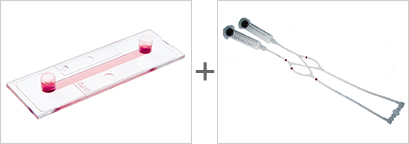Choosing the Optimal Setup for Your Experiment
- The Optimal Pump System for Your Experiment
- The Optimal Shear Stress for Your Experiment
- The Optimal Perfusion Set and Slide for Your Experiment
The Optimal Pump System for Your Experiment
Several pump systems are available on the market. Their different properties make them suitable for specific experimental requirements.
A syringe pump consists of a syringe, which is mounted onto a device that moves the plunger in a defined velocity. The outlet of the syringe can be connected to a tubing and a slide to create a flow in the slide. This easy-to-use device is mainly suitable for short-term experiments, where a relatively low medium volume and a slow to moderate flow rate are needed. More complex devices can also generate a circulating medium flow over the cells.
A peristaltic pump consists of a rotor with several contact points to the inserted tubing. The coils squeeze the tubing and thus move the medium forward. The peristaltic pump is suitable for long-term flow in parallel flow chambers.
The ibidi Pump System generates a flow by applying an air pressure onto the medium-filled reservoirs. By recirculation of the medium using a special switching pattern, a constant unidirectional flow is generated. This makes it an ideal setup for applying defined shear stress in long-term cell culture. Using the ibidi Pump System, it is possible to simulate continuous and pulsatile laminar flow, as well as oscillatory flow.
To help you find the pump system that fits your needs, please see the properties of the different pump systems, and whether they are applicaple for your flow type of choice, in the tables below:
Possible Flow Types | |||
| Syringe pump | Peristaltic pump | ibidi Pump System | |
| Circulating flow | Yes (only with push-and-pull pumps) | Yes | Yes |
| Long-term unidirectional flow | Yes (limited by volume) | Yes | Yes |
| Short-term flow | Yes | Yes (with limitations) | Yes (with limitations) |
| Pulsatile flow for simulating heartbeats | No | No | Yes |
| Oscillatory flow for simulating turbulences | Yes | No | Yes |
Pump System Characteristics | |||
| Syringe pump | Peristaltic pump | ibidi Pump System | |
| Pulsation | Almost none (only initial pulse) | Yes (undefined pulsation via drive shaft, depending on rotor type) | Almost none (only during valve activation) |
| Mechanical stress during pumping on non-attached cells held in a reservoir | Almost none (sedimentation can be a problem) | Strong | Very low |
| Combinable with microscopy | Yes | Difficult due to pulsation | Yes |
| Parallel experiments possible | Yes | Yes | Yes |
| Setup within an incubator | Difficult | Difficult | Easy |
| Long-term experiments possible with low medium volume | No | Yes | Yes |
| Programmability | Yes | Yes | Yes |
If you have further questions, please contact ibidi or your local distributor for a personal consultation.
Depending on the vessel type and tissue, the shear stress in a human body varies between almost 0 and over 100 dyn/cm². Information about the physiological shear stress that applies for your cell type of interest can be found here and in the literature.
It is crucial to perform preliminary experiments to determine at which shear stress level and after which time of conditioning the investigated protein or pathway reacts on the shear stress stimulus. Since the restructuring of the cell layer takes at least several days, it might be necessary to prolong the conditioning to such a long time frame.
Find detailed information about the shear stress-regulated factors and the corresponding response times in this review:
P.F. Davies. Flow-Mediated Endothelial Mechanotransduction. Physiological Reviews, 1995, 10.1152/physrev.1995.75.3.519
read abstract
ibidi Flow Calculator
Simple calculation tool
for your flow experiments
ibidi provides several Channel Slides with different volumes and geometries. These can be combined with the different ibidi Perfusion Sets, which are offered with varying inner diameters and tube lengths.
With each combination of a Perfusion Set and Channel Slide, a specific shear stress range can be achieved using the ibidi Pump System. Depending on the shear stress your setup requires, choose a suitable combination according to the Perfusion Set and µ-Slide Selection Guide.
General rules:
Higher shear stresses are created in Channel Slides with lower channels.
Lower shear stresses are created with smaller inner diameters in the tubing.

Explore the detailed Perfusion Set and µ-Slide Selection Guide.
Perfusion Set and µ-Slide Selection
Red (ID 1.6 mm) |
| Orange (ID 1.6 mm) | Blue (ID 0.8 mm) | White (ID 0.8 mm) | Grey (ID 0.8 mm) | Yellow (ID 0.5 mm) | Black (ID 0.5 mm) | Brown (ID 0.5 mm) | |||
| Tube length (cm) | 15 | 50 | 100 | 15 | 50 | 100 | 15 | 50 | 100 | ||
| Working volume (ml) | 12.6 | 13.3 | 14.3 | 12.4 | 12.6 | 12.9 | 2.5 | 2.6 | 2.7 | ||
| Standard reservoir* (ml) | 10 | 10 | 10 | 10 | 10 | 10 | 2 | 2 | 2 |
* By changing the reservoir, different working volumes can be achieved. Reservoirs are available with a syringe volume of 2, 10, and 50 ml.
Explore the detailed Perfusion Set and µ-Slide Selection Guide.
Suitability of Channel Slides for Different Shear Stress Ranges
The suitability of Channel Slides for different shear stress ranges depends on the channel height.
Please note: due to the very low channel height of 0.2–0.8 mm, the suitability of the Channel Slides for static cell culture is limited. Demanding, fast proliferating cells might be starving already after several hours if no fresh medium is added!

Read on and learn more about the Experimental Workflow of a Flow Assay, or about which Questions to Ask Before Starting an Experiment.




